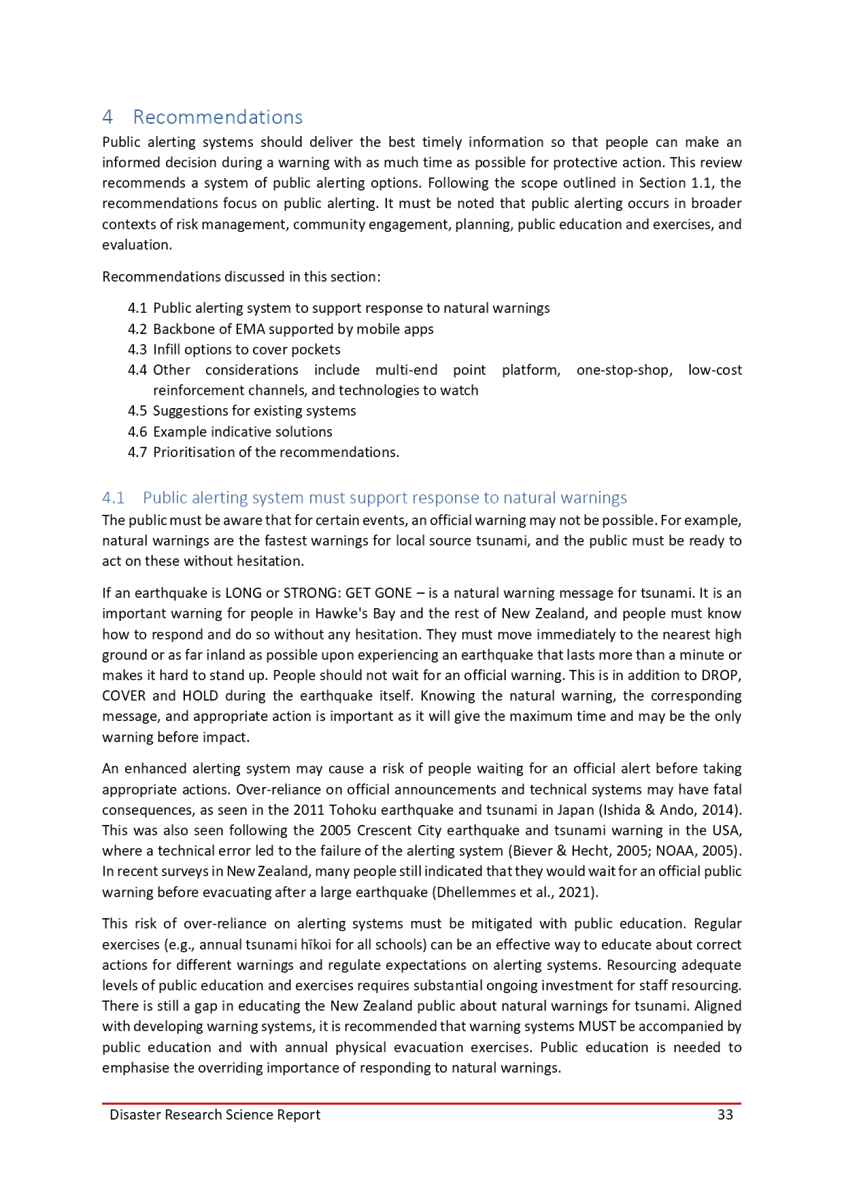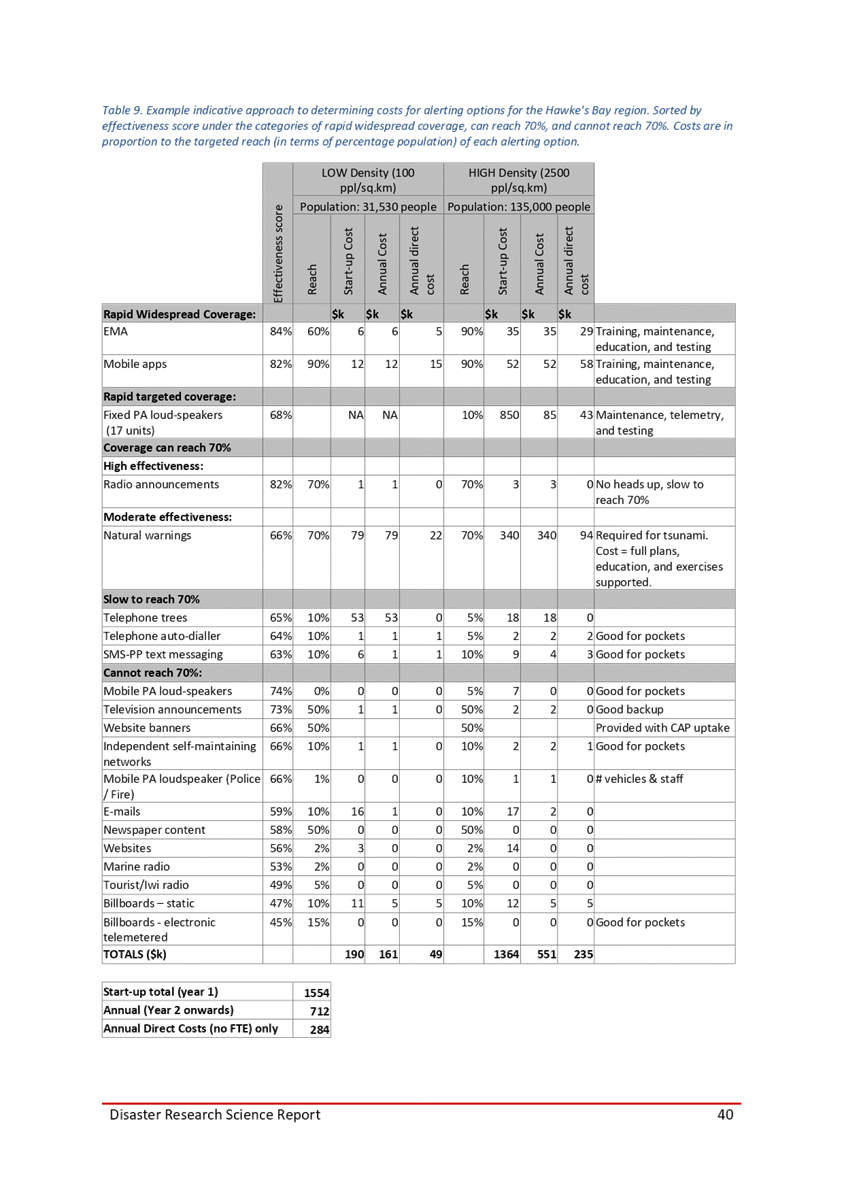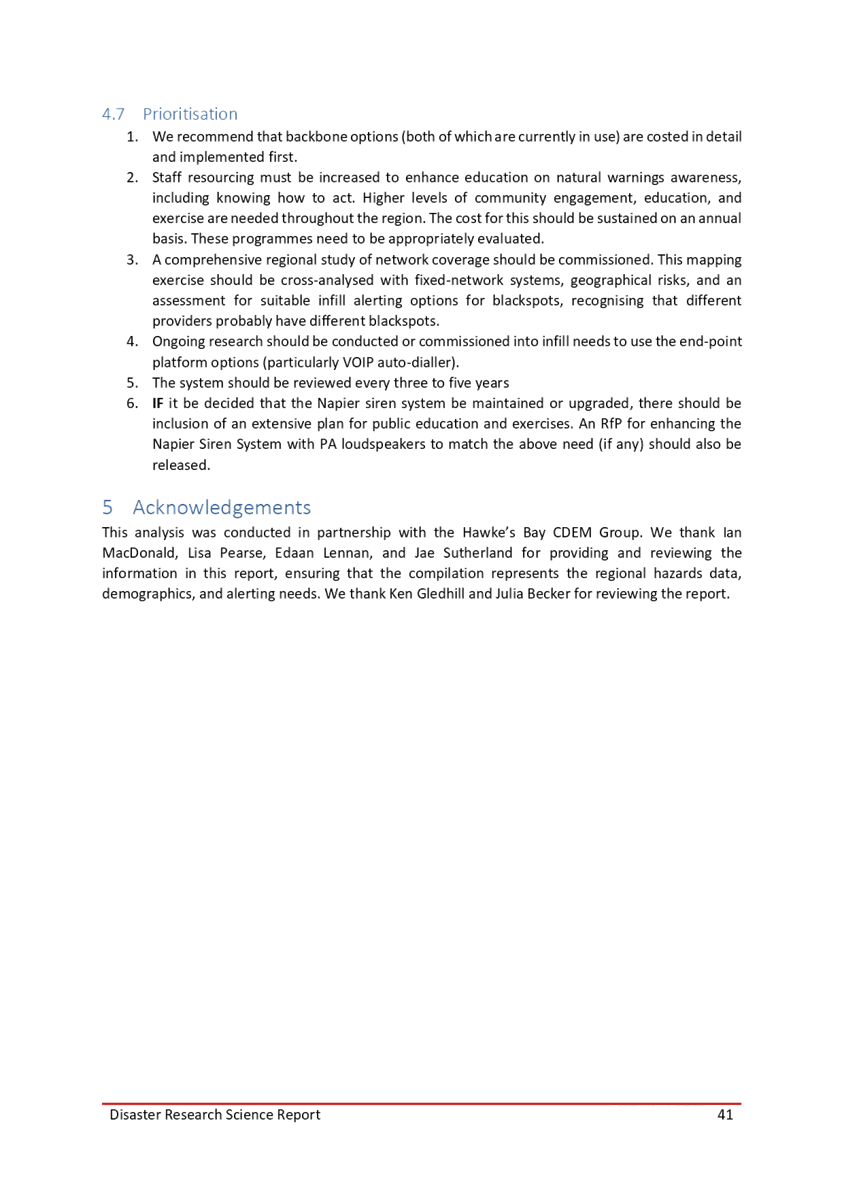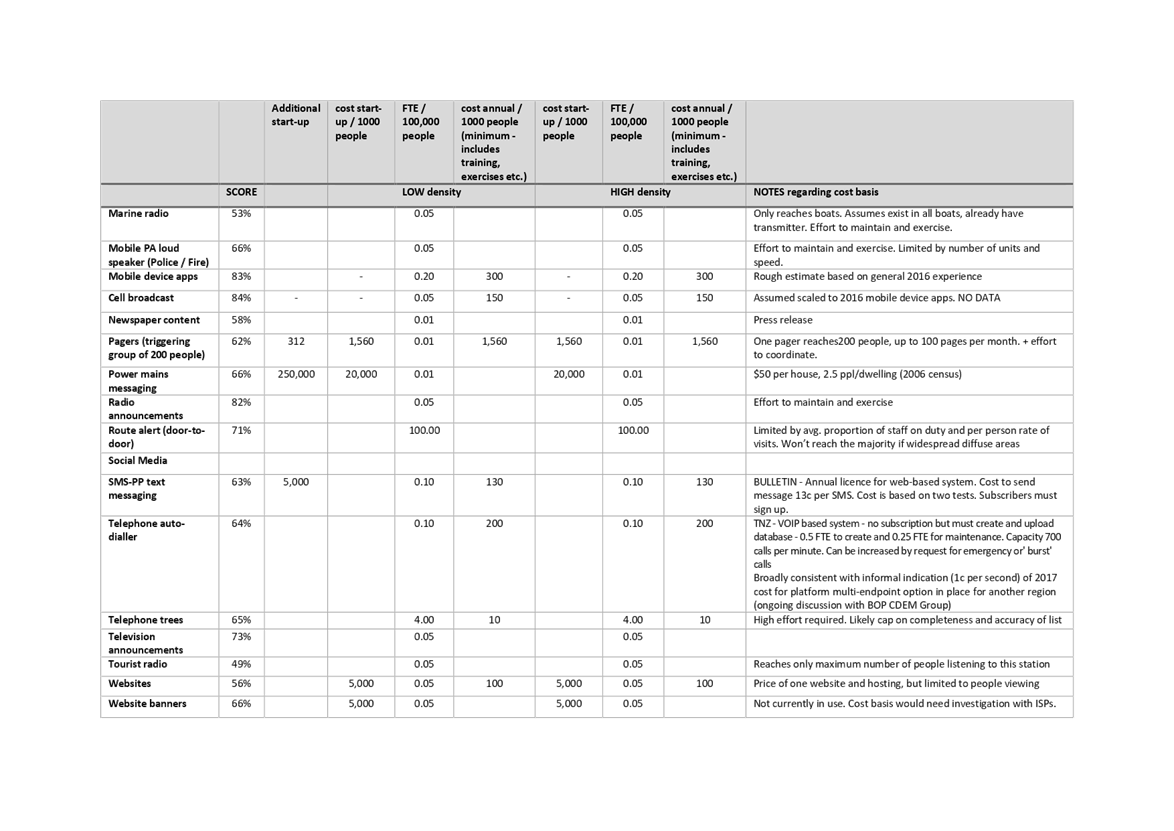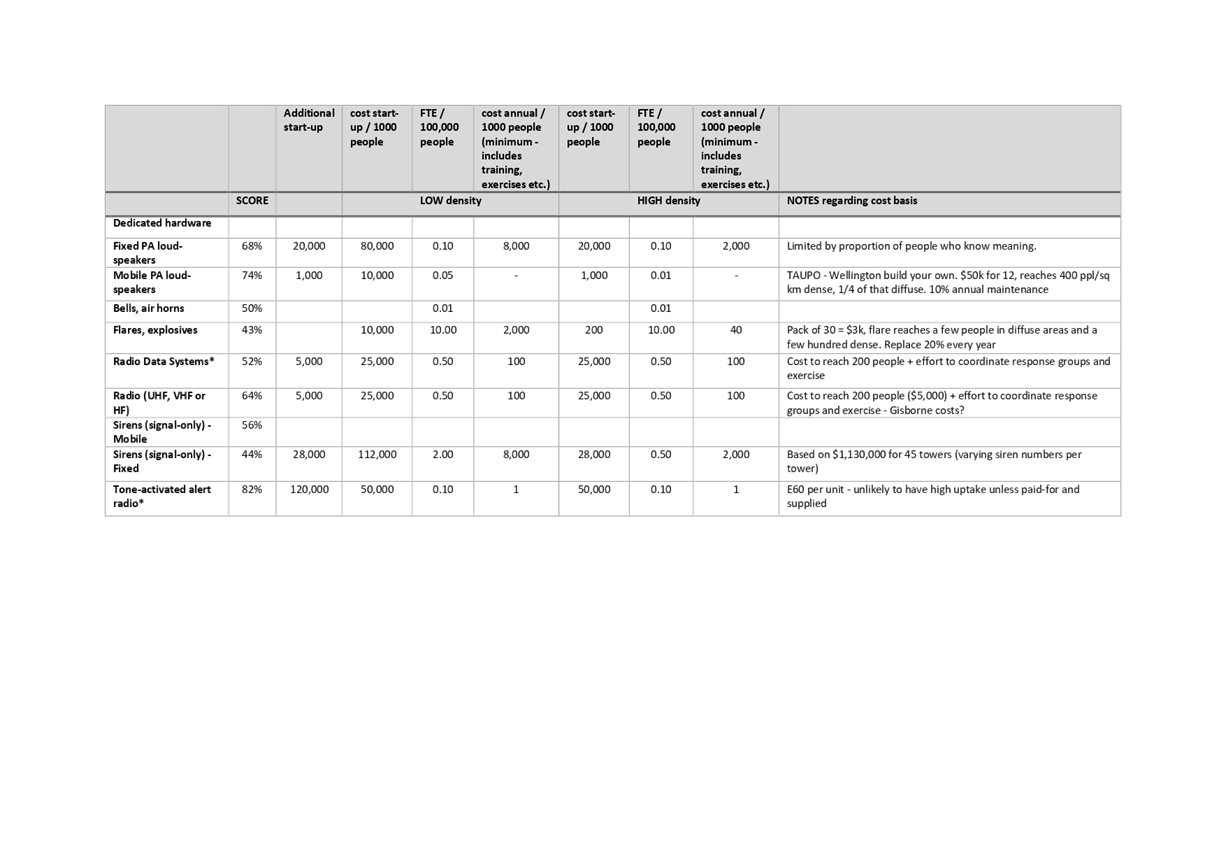Meeting of the HB
Civil Defence Emergency Management Group Joint Committee
Date: Monday 28 March 2022
Time: 1.30pm
|
Venue:
|
Council
Chamber
Hawke's
Bay Regional Council
159
Dalton Street
NAPIER
|
Agenda
Item Title Page
1. Welcome/Karakia/Notices/Apologies
2. Conflict
of Interest Declarations
3. Confirmation of Minutes of
the HB Civil Defence Emergency Management Group held on 22 November 2021
4. Action
items from previous HB CDEM Group Joint Committee meetings 3
5. Call
for Minor Items Not on the Agenda 7
Decision
Items
6. National
Emergency Management Agency Chief Executive Verbal Update
7. Amendments
to the Hawke's Bay CDEM Group Plan: Recovery Managers 9
8. Hawke's
Bay Regional Alerting Systems Review and Options 13
Information
or Performance Monitoring
9. Group
Manager's Update 67
10. Progress
Report: Strengthening CDEM in Hawke's Bay – Implementation Report 75
11. National
Emergency Management Agency Verbal Update
12. Discussion
of Minor Items not on the Agenda 89
HB CDEM Group Joint Committee
Monday 28
March 2022
Subject: Action items from previous HB CDEM Group Joint Committee meetings
Reason for Report
1. Attachment 1 lists items raised
at previous meetings that require action, and each item indicates who is
responsible, when it is expected to be completed and a brief status comment.
Once the items have been reported to the Committee they will be removed from
the list.
Decision Making Process
2. Staff have assessed the
requirements of the Local Government Act 2002 in relation to this item and have
concluded that, as this report is for information only, the decision-making
provisions do not apply.
Recommendation
That Hawke’s Bay
Regional Council receives and notes the Action items from previous HB CDEM
Group Joint Committee meetings.
Authored by:
|
Peter Martin
Senior
Governance Advisor
|
|
Approved by:
|
Ian Macdonald
CDEM Group
Manager/Controller
|
|
Attachment/s
|
1⇩
|
Action Items for HB CDEM Group Joint
Committee - March 2022 meeting
|
|
|
|
Action
Items for HB CDEM Group Joint Committee - March 2022 meeting
|
Attachment 1
|

HB CDEM Group Joint Committee
Monday 28
March 2022
Subject: Call for Minor Items Not on the Agenda
Reason for
Report
1. This item provides the
means for committee members to raise minor matters they wish to bring to the
attention of the meeting.
2. Hawke’s Bay Regional
Council standing order 9.13
states:
2.1 “A meeting may discuss an item that is
not on the agenda only if it is a minor matter relating to the general business
of the meeting and the Chairperson explains at the beginning of the public part
of the meeting that the item will be discussed. However, the meeting may not
make a resolution, decision, or recommendation about the item, except to refer
it to a subsequent meeting for further discussion.”
Recommendation
That the HB Civil Defence
Emergency Management Group Joint Committee accepts the following “Minor
items not on the agenda” for discussion as Item 12:
Authored by:
|
Peter Martin
SENIOR
Governance ADVISOR
|
|
Approved by:
|
Ian Macdonald
CDEM Group
Manager/Controller
|
|
Attachment/s
There are no attachments for this
report.
HB CDEM Group Joint Committee
Monday 28
March 2022
Subject: Amendments to the Hawke's Bay CDEM Group Plan: Recovery Managers
Reason for Report
1. Under the Civil Defence Emergency Management
Act 2002 (CDEM Act) the Civil Defence Emergency Management Group Joint
Committee makes appointments to the positions of Group Recovery Managers. These
appointments and associated delegations are contained in the Hawke’s Bay
CDEM Group Plan and as such represent a minor change to this Plan.
2. This item seeks confirmation of
proposed changes to Group Recovery Manager appointments and as a result,
proposes resulting minor changes to the Hawke’s Bay CDEM Group Plan.
Confirmation
of the Appointment of Group Recovery Managers Hawke’s Bay CDEM Group
3. Mr Mike Adye is currently appointed as
a Group Recovery Manager for the Hawke's Bay CDEM Group. Mike is currently
overseas for an extended period and has resigned from this role.
Discussions will be had with the CDEM Coordinating Executive Group (CEG) over
the future direction of recovery and this area is one of the projects
identified in the implementation of the “Strengthening CDEM in the
Hawke's Bay” report. Until then it is recommended that Mr Adye be removed
from the role of primary Group Recovery Manager. As the Plan identifies three
alternate Group Recovery Managers, the Group still has coverage in this area.
4. With the requirement in the CDEM Act
to appoint Group Recovery Managers, it was agreed that Hastings District
Council (HDC)and Napier City Council (NCC) would identify two alternates.
Hastings District Council has asked that their alternate be changed to Mr Bruce
Allan, their Group Manager Corporate.
5. Mr Allan has provided the following
resume:
5.1. Bruce is a Hawke’s Bay local,
who grew up on a farm on the Taihape Rd. Now a Chartered Accountant,
Bruce’s first appointment at HDC was as Strategic Financial Advisor in
2008. In addition to this role, he undertook a split role, working as Chief
Financial Officer for Central Hawke’s Bay District Council in 2014. Bruce
was seconded to the role of Acting Chief Financial Officer with HDC in February
2015 and appointed Chief Financial Officer in April 2016. Due to a restructure
in early 2020, Bruce now holds the title of Group Manager: Corporate,
reflecting his new management portfolio which includes the finance, IT,
customer services, procurement, risk management and security teams.
5.2. For nearly ten years, Bruce has been one of HDC’s
Recovery Managers, being involved in the Waimarama Road fire incident in 2017
and the Esk Valley Floods of 2018, developed the Council’s Covid-19 post
lockdown economic recovery plan and, most recently, as a member of the Covid
response team managing the current challenges facing the workplace and the
community.
6. The following changes are therefore
recommended to Appendix 5: Key Appointments to the Hawke’s Bay CDEM Group
Plan:
6.1. Add the following to the Recovery
Manager (Alternate) Hawke’s Bay CDEM Group list:
Bruce
Allan
6.2. Remove the following from the Recovery
Manager (Alternate) Hawke’s Bay CDEM Group list:
John
O'Shaughnessy
6.3. Remove the following from the Recovery
Manager (Primary) Hawke’s Bay CDEM Group list:
Michael
Adye.
Strategic Fit
7. The recommendations are consistent
with the Group Plan in that they provide for an effective response and recovery
to an emergency, a key objective of the Plan.
Financial
and Resource Implications
8. There are no significant financial or
resource implications that may result from this decision.
Decision Making Process
9. Committee is required to make every
decision in accordance with the requirements of the Local Government Act 2002
(the Act). Staff have assessed the requirements in relation to this item and
have concluded:
9.1. The decision does not significantly
alter the service provision or affect a strategic asset.
9.2. The use of the special consultative
procedure is not prescribed by legislation.
9.3. The decision does not fall within the
definition of the Administrating Authority’s (Hawke’s Bay Regional
Council) policy on significance and engagement
9.4. No persons can be identified who may
be affected by this decision.
9.5. The decision is not inconsistent with
an existing policy or plan.
9.6. Given the nature and significance of
the issue to be considered and decided, and also the persons likely to be
affected by, or have an interest in the decisions made, the Committee can
exercise its discretion and make a decision without consulting directly with
the community or others having an interest in the decision.
9.7. The proposed amendments to the Group
Plan meet the requirements of section 57 of the Civil Defence Emergency
Management Act 2002 and can be considered as a minor change to the Group Plan
that does not need public consultation.
|
Recommendations
That
the Hawke’s Bay CDEM Group Joint Committee:
1. Agrees that the decisions to be made
are not significant under the criteria contained in the Administrating
Authority’s (Hawke’s Bay Regional Council) adopted Significance
and Engagement Policy, and that the Committee can exercise its discretion
under Sections 79(1)(a) and 82(3) of the Local Government Act 2002 and make
decisions on this issue without conferring directly with the community and
persons likely to be affected by or to have an interest in the decision.
2. The Hawke’s Bay CDEM Group
Joint Committee resolves to amendment Appendix 5: Key Appointments of the
Hawke’s Bay CDEM Group Plan pursuant to section 57 of the Civil Defence
Emergency Management Act 2002 and make appointments and changes to the roles
of Local Controller as follows:
2.1. Add the following to the Recovery
Manager (Alternate) Hawke’s Bay CDEM Group list:
Bruce
Allan
2.2. Remove the following from the
Recovery Manager (Alternate) Hawke’s Bay CDEM Group list:
John O'Shaughnessy
2.3. Remove the following from the
Recovery Manager (Primary) Hawke’s Bay CDEM Group list:
Michael
Adye
|
Authored and Approved by:
|
Ian Macdonald
CDEM Group
Manager/Controller
|
|
Attachment/s
There are no attachments for this
report.
HB CDEM Group Joint Committee
Monday 28
March 2022
Subject: Hawke's Bay Regional Alerting Systems Review and Options
Reason
for Report
1. The purpose of this report is to
provide the HB CDEM Group Joint Committee with a copy of the report Hawke's Bay
Regional Alerting Systems Review completed by Massey University’s Joint
Centre for Disaster Research and to inform the Committee of the CDEM
Coordinating Executive Group’s (CEG) decision on the approach to public
alerting moving forward.
2. It is asked that the Committee resolve
to:
2.1. Note the attached Massey report
2.2. Endorse the decision of the CEG, that
the Emergency Mobile Alert (EMA) system becomes the backbone system for public
alerting in Hawke's Bay supported by mobile apps such as the Red Cross Hazard
application (app)
2.3. Support the implementation of this
decision
2.4. Support the Napier City
Council’s (NCC) decision to disestablish their tonal only siren system.
Executive
Summary
3. Massey University conducted a gap
analysis and reported on a review of the current suite of public alerting tools
in the Hawke's Bay region. It also assessed the suitability of other alerting
options for use across the region.
4. To be effective, public alerting
systems should deliver information so that people can make an informed decision
during a warning with as much time as possible for action that provides for
their safety.
5. The critical considerations for
alerting are providing a heads-up and instructions. The heads-up is the ability
to gain people’s attention and inform of the threat before it occurs.
Instructions are the ability to provide details: what is happening, where,
when, and what action is required to respond to the threat.
6. This review recommends a system of
public alerting options including:
6.1. Emphasis on natural warnings (e.g. for
local tsunami Long or Strong, Get Gone)
6.2. The use of the national EMA system as
a backbone for public alerting
6.3. The identification and use of infill
systems where there is a lack of mobile phone coverage or there is a need to cover groups or communities for which cell alerts are not appropriate.
7. The report also recommends that the
Hawke's Bay CDEM Group carry out further work with mobile phone providers to
better map coverage areas and develop an end to end or one-stop system and
process.
8. The Massey report is attached to this
report.
Strategic
Fit
9. The decisions in this report relate to
the following Readiness Objective in the Group Plan:
9.1. RES5: Ensure that the Hawke’s
Bay CDEM Group maintains and where appropriate practices a coordinated, mass
public alerting system.
Background
10. Last year Group Office staff commenced
working with Napier City Council (NCC) on the future of the Napier tonal siren
system. The Group commissioned the Massey University Joint Centre for Disaster
Research to undertake a technical review and develop options. It was
subsequently decided that it was more effective and efficient to broaden the
review to include the entire Group area.
11. On 3 February 2022 the Napier City
Council People and Places Committee resolved to disestablish the existing
outdated Napier siren system which no longer complies with New Zealand
standards and has inherent operational risks. They agreed that the Emergency
Management Alert (EMA) system was the best public alerting system for Napier
backed up with related public education. They resolved to support the Group in
providing the EMA and education. This decision was subsequently agreed to at a
Council meeting on 17 March 2022.
12. On 28 February 2022 the CDEM
Coordinating Executive Group (CEG) considered the report and its
recommendations and agreed that for the Group area, the EMA system was the best
back bone public alerting system with other systems such as opt in internet and
messaging systems being used for infill where there was no cell phone coverage.
It was also agreed that a project be developed to implement these decisions and
develop an associated public education and media awareness programme.
13. The current situation with regards to
mass public alerting nationally, and in Hawke's Bay is described in the report.
This includes the characteristics of the EMA and other systems.
14. Currently the Group has access to the
EMA portal and on the approval of a group controller, an EMA may be issued
within Hawke’s Bay. Obviously, there is a requirement for this to be tightly
controlled and an EMA may only be issued for ‘high-priority alerts’
that meet set criteria for “certainty, severity, urgency”. As such
the Group needed to agree to a terms of use document with NEMA and mobile phone
providers.
15. Group office staff have been trained
and practiced on the system. NEMA tightly control access to the system. NEMA
may also issue EMAs for a region if requested, while a further back up through
the Fire and Emergency New Zealand (FENZ) Communications Centre can also be used
by the Group.
16. The EMA utilises cell phone towers
across all operators in New Zealand to deliver a message directly to an
individual’s mobile phone. This is an opt out service which can only be
disabled in the phone settings. All new cell phones sold in New Zealand have
this setting enabled by default.
17. The Group also has access to the Red
Cross application (app). This is an opt-in internet based alerting system which
is provided and maintained by the Red Cross and uses and individual’s
internet connection (as opposed to the cell phone network) to deliver alerts.
This app is based on the Common Alerting Protocol (CAP), as is the EMA system.
This allows for the two systems to be linked so the alert from one is
transmitted across both systems almost simultaneously.
18. The report recommends that an internet
app is a preferred solution for those people who live outside of cell phone
coverage.
19. An important part of implementing this
decision will be media, public education and information, signage, and other
public engagement activities such as community resilience planning.
Discussion
20. The report identified, analysed, and
recommended the different contemporary options for mass public alerting for
Hawke's Bay.
21. The development of the national EMA
system is a ‘game changer’ in public alerting for major emergencies
in New Zealand. As the system has been used and tested on a number of occasions
in the last few years, there is confidence in the resilience and reach of the
system.
22. Whilst already having the capability
to issue EMAs, further strengthening of the systems and processes underlying
mass public alerting for the Group needs to occur. This could include:
22.1. Further training and exercising on the
EMA, Regional Warning System, and the Red Cross Hazards application (app)
22.2. Development of Hawke's Bay specific
templates for a range of regional/local hazards
22.3. Development of end-to-end delivery
between systems using the CAP
22.4. Work with emergency services and
councils to better identify protocols and processes that allow them to recommend
issuing an EMA locally
22.5. Development of a business case of
opt-in alerting for members of the public who have a duty of care over others
(e.g. coastal campgrounds)
22.6. Public education on what the preferred
systems are, how to access them and what to expect
22.7. Working with community groups who need
separate or different ways of alerting their community.
23. Group staff will develop a more
detailed project plan to be included in the Group work programme currently
being developed for 2022-2024, and this will be reported back to the CEG.
Next
Steps
24. Group office staff will consult with
our regional partners, develop a more detailed project plan, and report back to
the CEG at its next meeting on 23 May 2022.
Decision
Making Process
25. The Joint Committee is required to
make every decision in accordance with the requirements of the Local Government
Act 2002 (the Act). Staff have assessed the requirements in relation to this
item and have concluded:
25.1. The decision does not significantly
alter the service provision or affect a strategic asset
25.2. The use of the special consultative
procedure is not prescribed by legislation
25.3. The decision does not fall within the
definition of the Administrating Authority’s (Hawke’s Bay Regional
Council) policy on significance and engagement
25.4. No persons can be identified who may
be affected by this decision
25.5. The decision is not inconsistent with
an existing policy or plan
25.6. Given the nature and significance of
the issue to be considered and decided, and also the persons likely to be
affected by, or have an interest in the decisions made, the Committee can
exercise its discretion and make a decision without consulting directly with
the community or others having an interest in the decision.
Recommendations
That the Hawke's Bay CDEM Group Joint Committee:
1. Receives and notes the Hawke’s
Bay regional alerting systems review and options staff report.
2. Receives and notes the Massey
University report Hawke's Bay Regional Alerting Systems Review December 2021
attached to this paper.
3. Endorses the decision of the CEG that
the Emergency Mobile Alert (EMA) system becomes the backbone system for public
alerting in Hawke's Bay supported by mobile apps such as the Red Cross Hazard
app.
4. Supports the implementation of this
decision.
5. Supports the NCC decision to
disestablish their tonal only siren system.
Authored and Approved by:
|
Ian Macdonald
CDEM Group
Manager/Controller
|
|
Attachment/s
|
1⇩
|
Massey University Report HB Regional
Alerting Systems Review DSR Report 2021 4
|
|
|
|
Massey
University Report HB Regional Alerting Systems Review DSR Report 2021 4
|
Attachment 1
|



















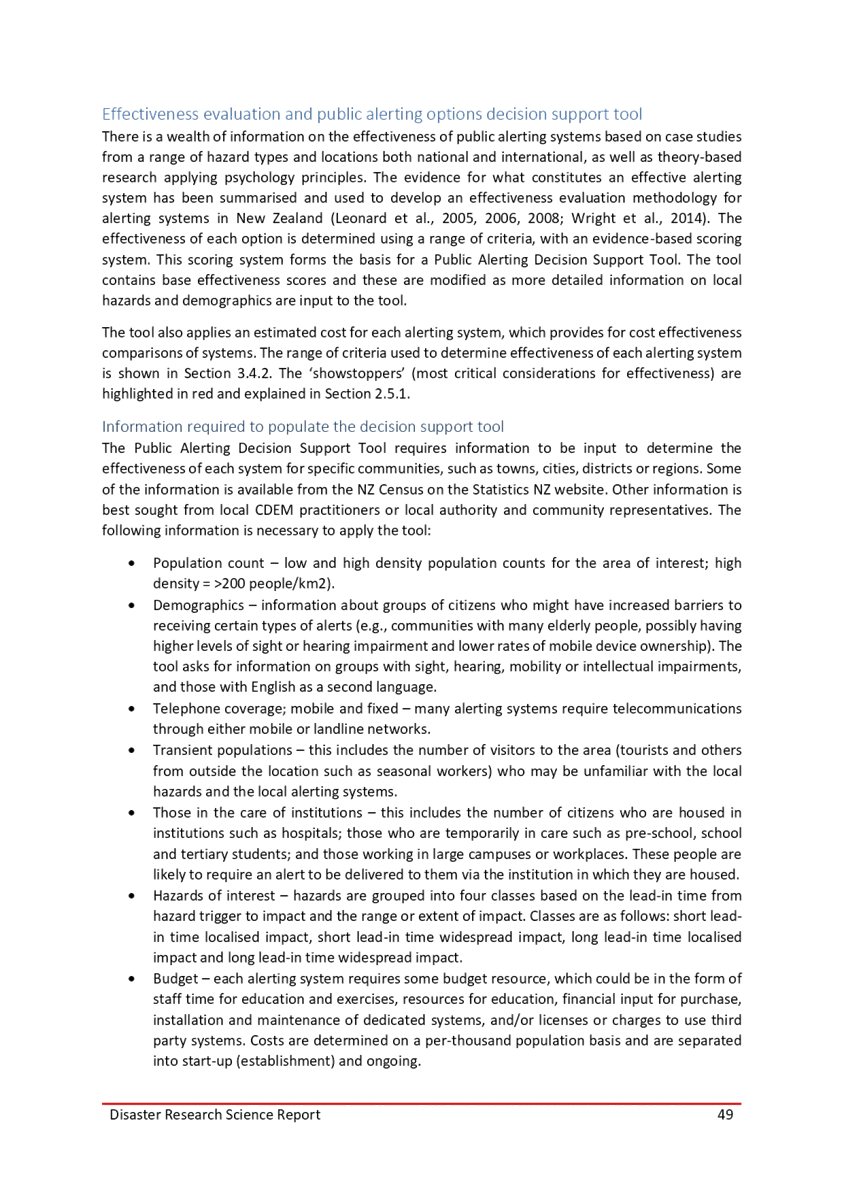

HB CDEM Group Joint Committee
Monday 28
March 2022
Subject: Group Manager's Update
Reason
for Report
1. The purpose of this report is to
inform and update the Joint Committee on matters not specifically addressed in
other items on this agenda and to give the Committee an opportunity to ask
questions and give feedback if desired.
Background
2. The matters covered in this report
include:
2.1. Group Office Staffing
2.2. Hawke's Bay CDEM Covid-19 Response and
Business Continuance
2.3. Central Government Emergency Management
Reforms (Trifecta)
2.4. Community Resilience Work Update
2.5. Operational Readiness Work Update
2.6. Financials update.
Discussion
Group Office Staffing
3. The Group office team went through
some significant change since the end of the first Covid-19 response. Since the
last Committee meeting, we have recruited two new staff members into the EMA
Community Resilience role based in Wairoa and the Recovery and Lifelines role
respectively. This last role is new and was approved through the 2021 Long Term
Plan process.
4. Unfortunately, Lisa Pearse (Team
Leader Risk Reduction) decided to retire and finished work last month. This is
a huge loss in terms of Lisa’s knowledge and standing across the country
in hazard research/risk reduction and her experience over the years in
responding to a wide range of events.
5. Recently we have had another staff
member resign to take up a role with NEMA. We are currently working through the
process of recruiting for both roles.
6. Looking at the team overall, we have
recruited well, and the team has good unity, morale, and individual technical
skills. However, what we are lacking in specific experience in CDEM responses
and coordination in a multi-agency environment. This will be a challenge for
the rest of the year as we rebuild from the ongoing responses of the last two
years.
Hawke's
Bay CDEM Covid-19 Response and Business Continuance
7. The GECC is currently continuing to
the support the Hawke's Bay District Health Board (HB DHB) and Ministry for Social
Development (MSD) in the response.
8. As a result of a request for support
from the DHB, in the last two weeks we have deployed two staff members to
advise and support the DHB led Covid Response Coordination Centre.
9. The staff involved are the Group
Welfare Manager and Team Leader Community Engagement. This secondment is
for up to 6 weeks and 2 weeks respectively. This is primarily to assist in the
further development of the processes and support for the initial clinical needs
assessment for positive persons, and linkages with the welfare needs
assessment.
10. As part of the agreement with the DHB,
these staff will be released should a concurrent event occur.
11. In terms of the Group capability,
currently the Group office is at full capability (less one vacancy and staff on
secondment) with some staff having already recovered from Covid or completed
self-isolation requirements.
12. Of more concern is the ability of
Council staff to support any significant response with most councils now
operating at reduced levels. This is also a concern at a national level, and it
is likely that if any significant event was to occur in any region, national
resources would be deployed, and planning has occurred to enable this.
Central
Government Emergency Management Reforms (Trifecta)
13. This NEMA programme of work continues,
and a discussion document for feedback was released just before the Christmas
period. Several stakeholder workshops were held at the end of January and
feedback closed on 11 February. The CDEM Group gave feedback on the limited
information that was provided. This feedback was formulated in conjunction with
the Joint Committee and CEG Chair and is attached to this item. Individuals and
organisations were able to provide their own feedback if desired.
14. The next stage of the process is for
an Emergency Management Bill to be developed and it is expected this will be
completed mid-year and be introduced into Parliament towards the end of the
year.
15. NEMA staff members will be at the
meeting and will be able to answer any questions the Committee has on the
proposed sector reforms.
Community
Resilience Work Update
16. Tsunami Hikoi Week was 7-13 March.
This was led by East Coast LAB. The Group promoted this to all schools and
early learning services via email, marae via the local Taiwhenua, tourism
businesses via Tourism Hawke’s Bay, and Napier business via the business
associations.
17. A new tsunami information board has
been designed and installed in three Napier locations, with more to follow. We
are now working with local council Māori advisors to create a bilingual
tsunami information board.
18. Tsunami signage installation is
ongoing, with information boards, evacuation routes, and tsunami blue line
installations being planned across the region. Group office staff will work
with the councils’ staff and agencies such as Waka Kotahi as part of this
process.
19. New tsunami public education
collateral is being co-designed with NEMA.
20. Translation of Te Hīkoi a
Rūaumoko into five additional languages is underway, working with
representatives from the Samoan, Tongan, Cook Island, Hindi, and Chinese
communities. This is being funded by the NEMA Resilience Fund with the Group
office supplying staff time.
21. The Resilience Fund East Coast LAB
project creating tsunami pou was completed with Waimarama school, marking their
tsunami safe location. This was completed using donated Unison power poles. The
Group office is looking at how this may be included in ongoing tsunami risk
reduction work.
22. Following the Tongan volcano event and
tsunami, we coordinated a meeting to bring together local Tongan leaders,
Tongan RSE representatives, Red Cross, and Hastings District Council, to
acknowledge what had happened in Tonga and identify local Tongan community
response ideas. Following this fono, we arranged for GNS to provide information
to the Hawke’s Bay Tongan community (in English and Tongan) about
volcanoes and their impacts. We will also be providing support to the local
Tongan container project, enabling local Tongan families to send one drum each
of clothing and non-perishable goods to their family in Tonga; This is being
planned in March.
Operational
Readiness Work Update
23. Leadership and support of the projects
initiated under the Strengthening CDEM Arrangements in Hawke's Bay
report have been a key focus of the operational team staff.
24. The Group office has purchased a
prototype Starlink satellite unit, allowing broadband speed satellite
connection. The cost/bandwidth/speed ratio is approximately 50 times better
value for money than the Iridium network which most existing satellite
technology use. This is very new and disruptive technology for resilient
communications, and we are currently assessing its capabilities, with a view to
it possibly replacing our current Iridium satellite communications
infrastructure.
25. A Memorandum of Understanding (MoU)
has been developed with the Amateur Radio Emergency Communicators (AREC) for
the provision of VHF radio network management and advice before and during an
emergency. This will mitigate some of the risks caused by aging VHF radio
infrastructure and workforce.
26. Several CIMS training modules have
been redeveloped into online modules and made available to staff in councils
through council People and Capability teams. CIMS level three accreditation is now online, and the Group office
is delivering face-to-face courses for staff to become accredited.
27. ArcGIS training has also been provided
across a wide range of CDEM staff and partners to support the development of a
Common Operating Picture.
28. Volunteer training has restarted this
year with an emphasis on personal/situational safety and utilising the
Multi-Habitation Unit (MHU) that was provided as part of the National
Resilience Cache.
29. Support is being provided to TPK's
Kāinga Rua project in partnership with FENZ by way of advice about Marae
Resilience Caches and assistance to facilitate training/Wānanga
for hapū on establishing a community led civil defence centre.
Financial
update
30. The table below outlines the budget
position as of 31 December 2021. It is likely that we will also deliver a small
surplus for the next 6 months of the financial year due primarily to savings in
salaries as we recruit staff replacements.
31. Overall, the budgets are on track to
delivering a surplus of up to $100,000 which would be moved into the CDEM
Reserves.
|
Workstream
Description
|
ACTUAL
31 Dec YTD
|
BUDGET
31 Dec YTD
|
Unfavourable/
(Favourable) Variance
|
|
|
|
|
|
Reduction – Hazard Identification and Mitigation
|
|
|
|
|
Revenue
|
($102,022)
|
($117,308)
|
$15,286
|
|
Expenses
|
$38,975
|
$41,884
|
($2,909)
|
|
Internal
|
$116,641
|
$150,243
|
($33,602)
|
|
$53,594
|
$74,819
|
($21,224)
|
|
|
|
|
|
|
|
|
|
Operational Readiness
|
|
|
|
|
Revenue
|
($379,288)
|
($343,313)
|
($35,975)
|
|
Expenses
|
$98,582
|
$147,453
|
($48,871)
|
|
Internal
|
$542,718
|
$469,236
|
$73,481
|
|
$262,012
|
$273,377
|
($11,365)
|
|
|
|
|
|
|
|
|
|
Group Leadership and Governance
|
|
|
|
|
Revenue
|
($291,804)
|
($284,858)
|
($6,946)
|
|
Expenses
|
$2,277
|
$14,120
|
($11,842)
|
|
Internal
|
$147,216
|
$114,908
|
$32,308
|
|
($142,311)
|
($155,830)
|
$13,520
|
|
$0
|
$0
|
|
|
$0
|
$0
|
|
|
Community Engagement and Resilience
|
|
|
|
|
Revenue
|
($365,486)
|
($352,469)
|
($13,017)
|
|
Expenses
|
$40,598
|
$30,305
|
$10,293
|
|
Internal
|
$297,172
|
$325,115
|
($27,943)
|
|
($27,715)
|
$2,952
|
($30,667)
|
|
|
|
|
|
|
|
|
|
Emergency Management Totals
|
$145,580
|
$195,317
|
($49,737)
|
Decision Making Process
32. Staff have assessed the
requirements of the Local Government Act 2002 in relation to this item and have
concluded that, as this report is for information only, the decision making
provisions do not apply.
|
Recommendation
That the Hawke’s Bay CDEM
Group Joint Committee receives the Group Manager’s update
report.
|
Authoredand Approved by:
|
Ian Macdonald
Group
Manager/Controller
|
|
Attachment/s
|
1⇩
|
Modernising the Emergency Management
Framework Initial Written Feedback
|
|
|
|
Modernising
the Emergency Management Framework Initial Written Feedback
|
Attachment 1
|



HB CDEM Group Joint Committee
Monday 28
March 2022
Subject: Progress Report: Strengthening CDEM in Hawke's Bay –
Implementation Report
Reason
for Report
1. The purpose of this report is to give
the Committee an update on the work programme implementing the recommendations
of the report “Strengthening CDEM in Hawke's Bay”.
Background/Discussion
2. At its last meeting in November 2021
the Committee discussed and endorsed an outline work program to implement the
recommendations of the report “Strengthening CDEM in Hawke's Bay”.
3. Since this time the project leads for
key projects have been identified and project scopes have been further
developed. All of this has been against the background of further work and
disruption through supporting the all off government planning and response to
Covid-19 as we move into the next phase of the pandemic.
4. This disruption and changing
priorities have not just been to Group office staff, with staff from councils
and partner agencies also needing to respond to BCP responsibilities and
constraints on the ability to participate with the change process. Meetings of
project groups will be more challenging now that Omicron is established in the
community and organisations move to preserving operational capability through
working from home and work isolation teams.
5. Despite the challenges of the last
couple of months the programme remains on track. An up-to-date Programme
Monitoring Report and timeline is attached.
6. These two monitoring reports will
continue to be refined as the programme implementation continues.
Next
Steps
7. Reporting on the work programme
against the recommendations and outcomes of the Report will be further
developed and continue for the next Committee meeting.
Decision
Making Process
8. Staff have assessed the requirements
of the Local Government Act 2002 in relation to this item and have concluded
that, as this report is for information only, the decision making provisions do
not apply.
Recommendation
That
the CDEM Group Joint
Committee receives and notes the Progress report: Strengthening CDEM in
Hawke's Bay – implementation report.
Authored and
Approved by:
|
Ian Macdonald
CDEM Group Manager/Controller
|
|
Attachment/s
|
1⇩
|
Strengthening CDEM in HB
Programme Monitoring Report
|
|
|
|
2⇩
|
Strengthening CDEM in HB Timeline
|
|
|
|
Strengthening
CDEM in HB Programme Monitoring Report
|
Attachment 1
|
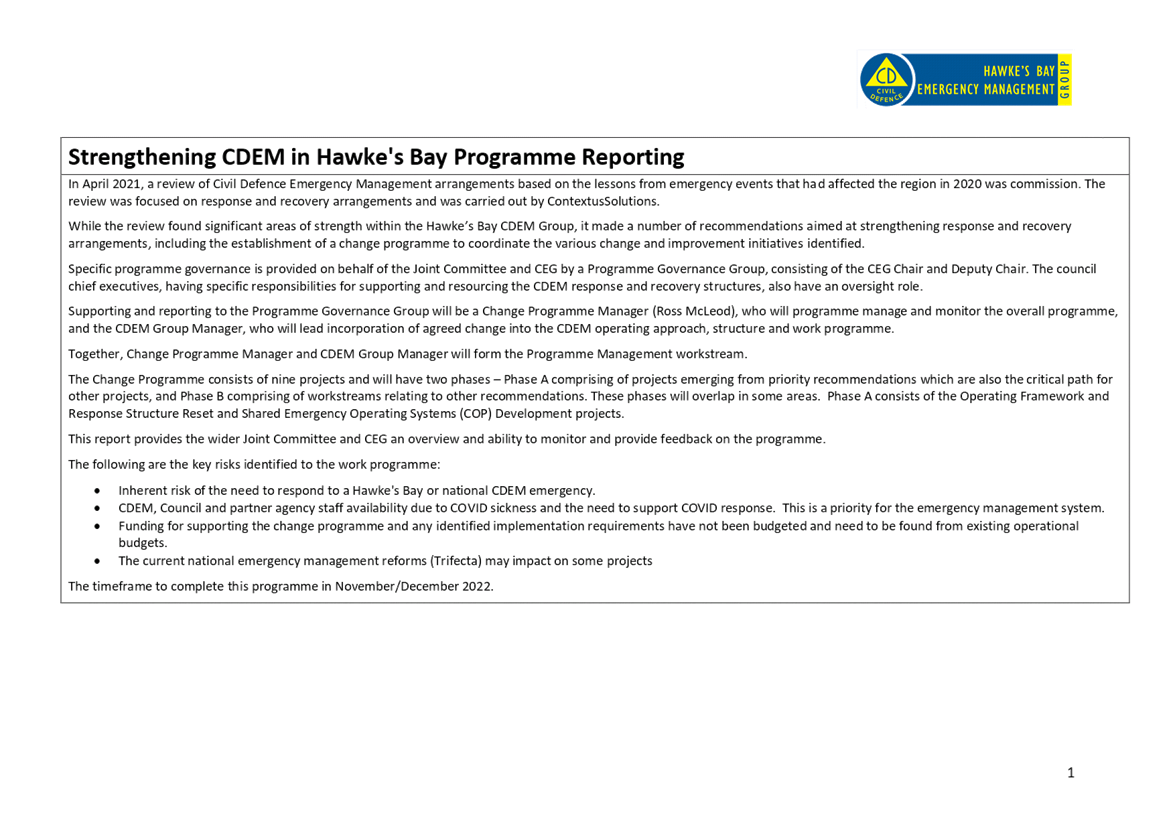

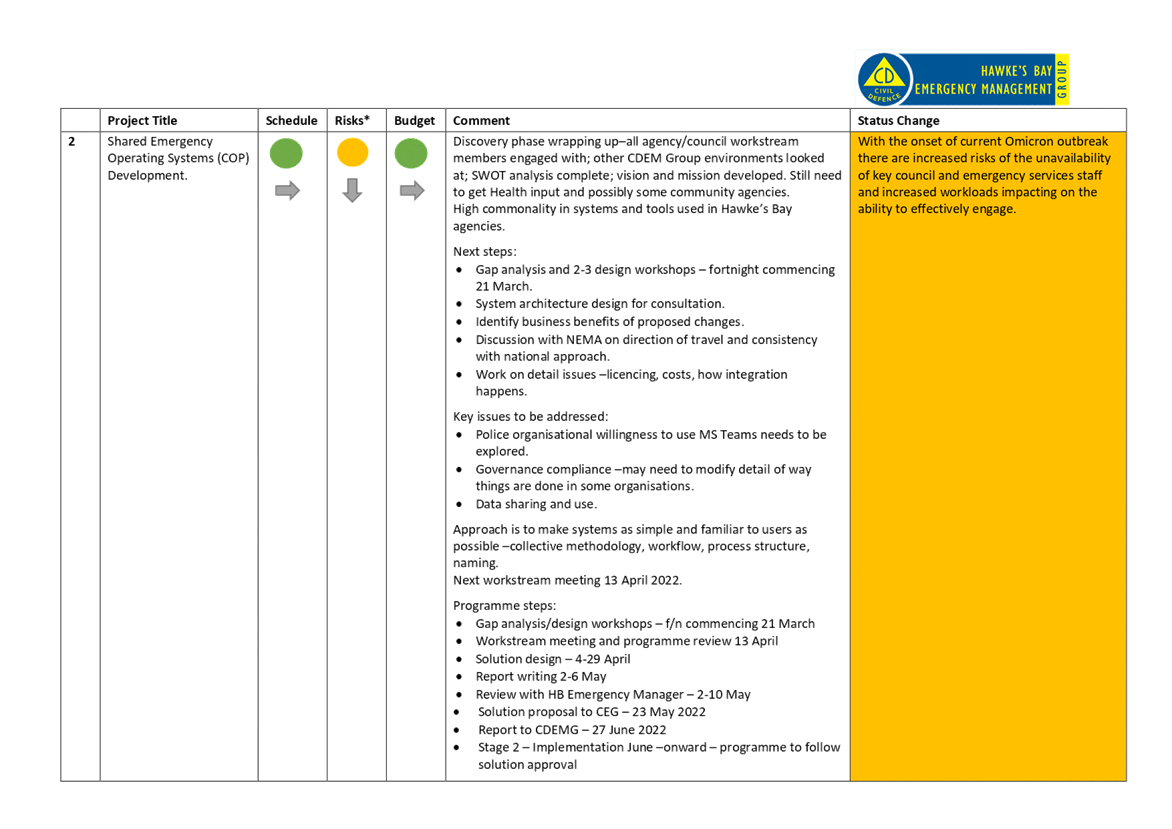
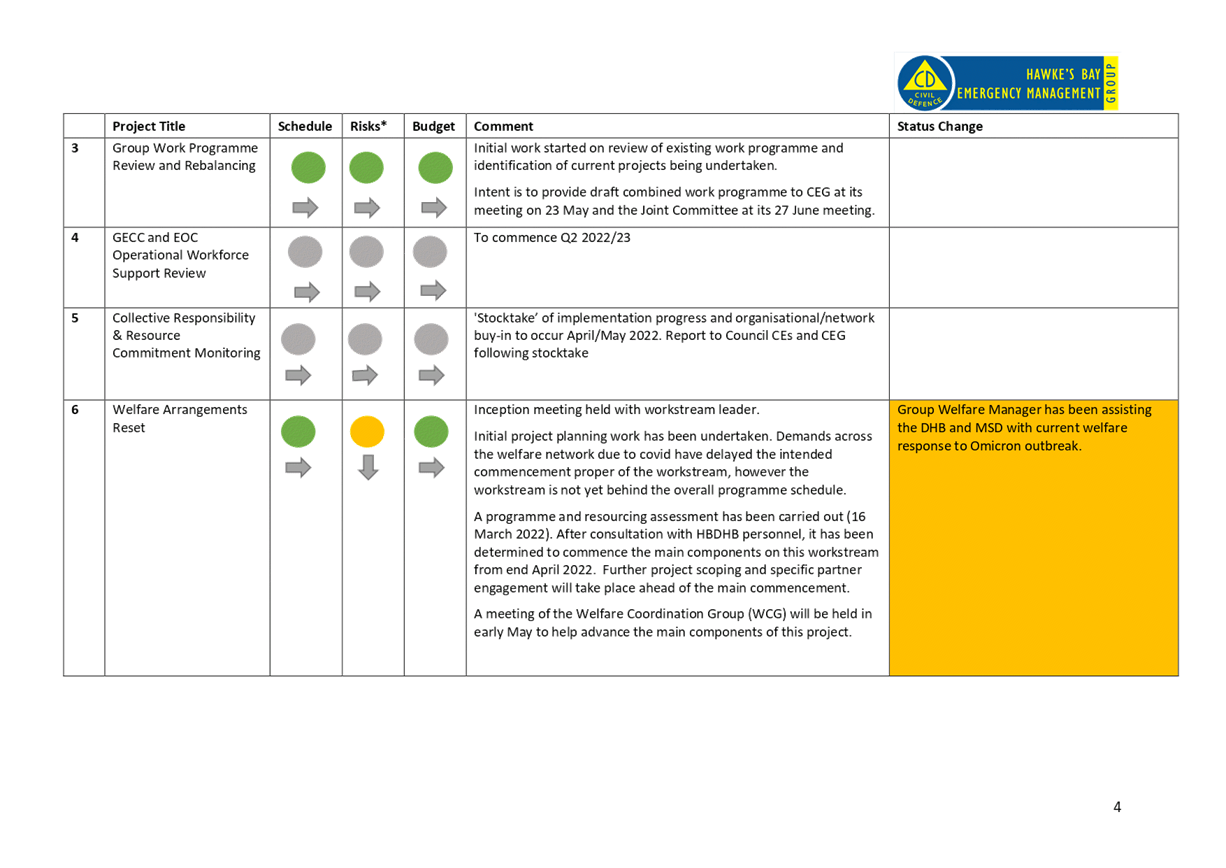
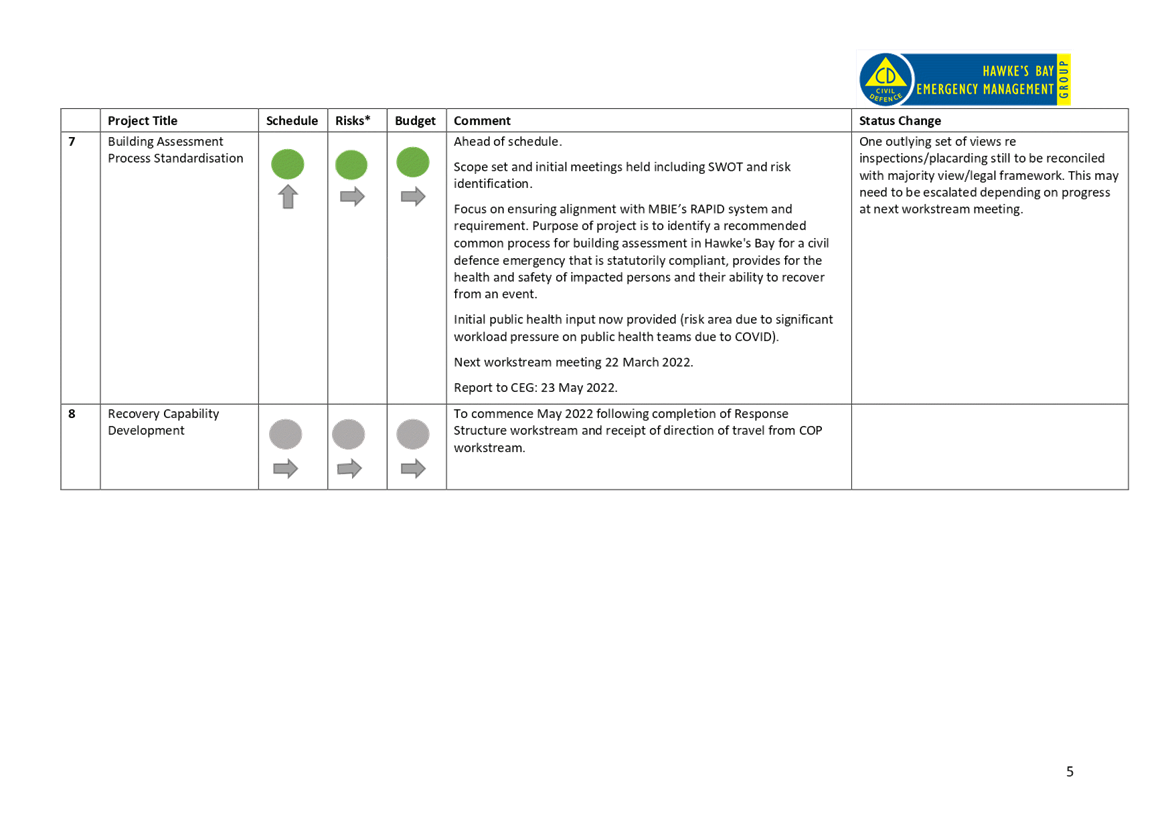
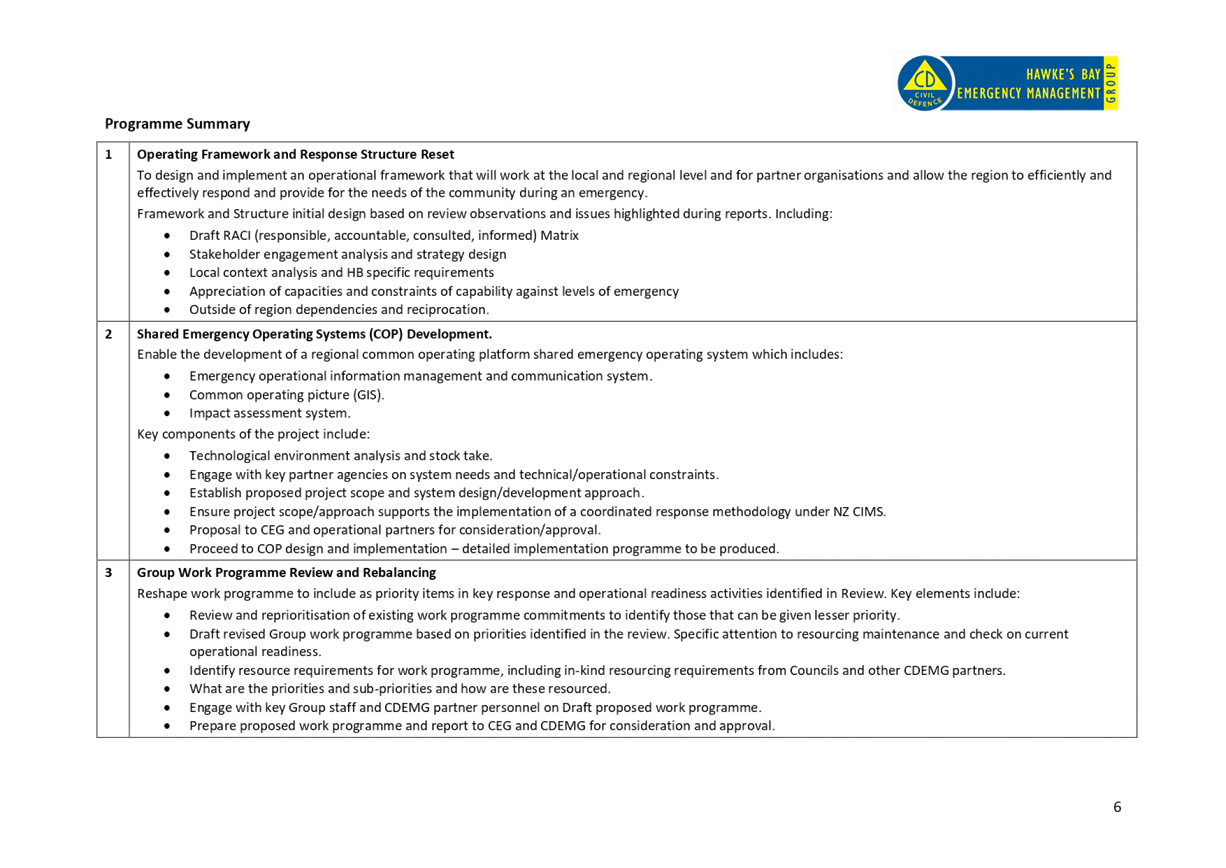
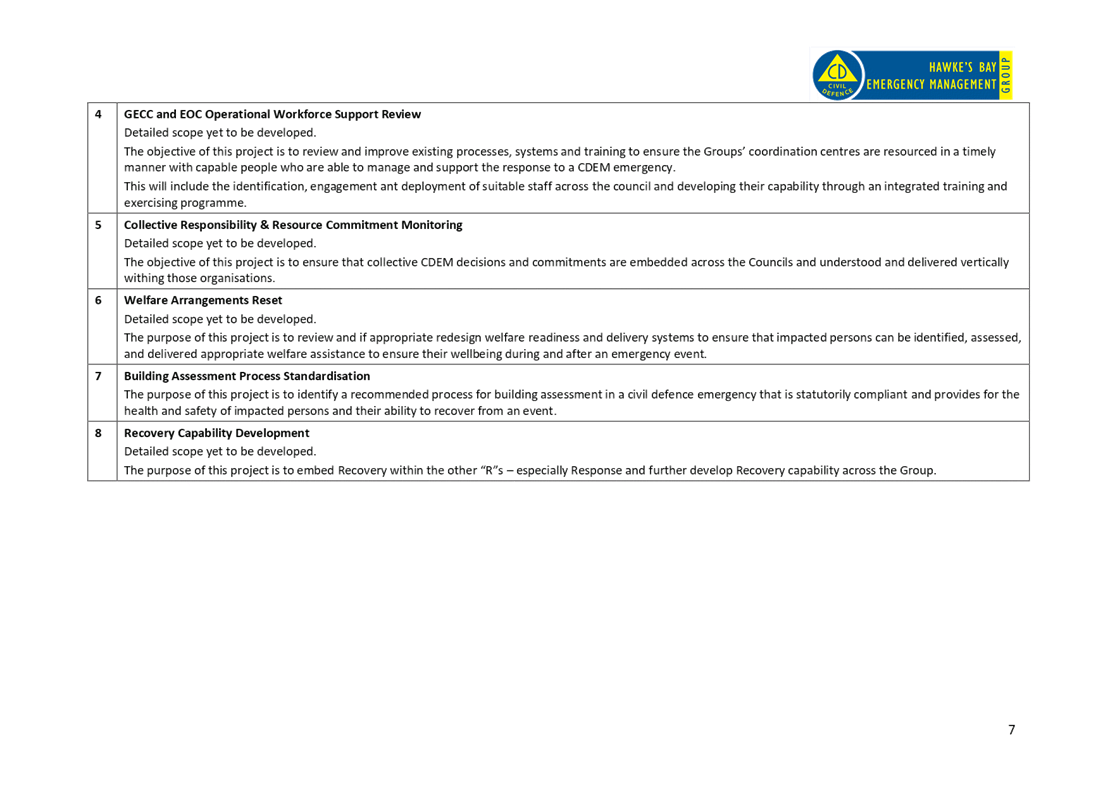
|
Strengthening CDEM in HB
Timeline
|
Attachment 2
|
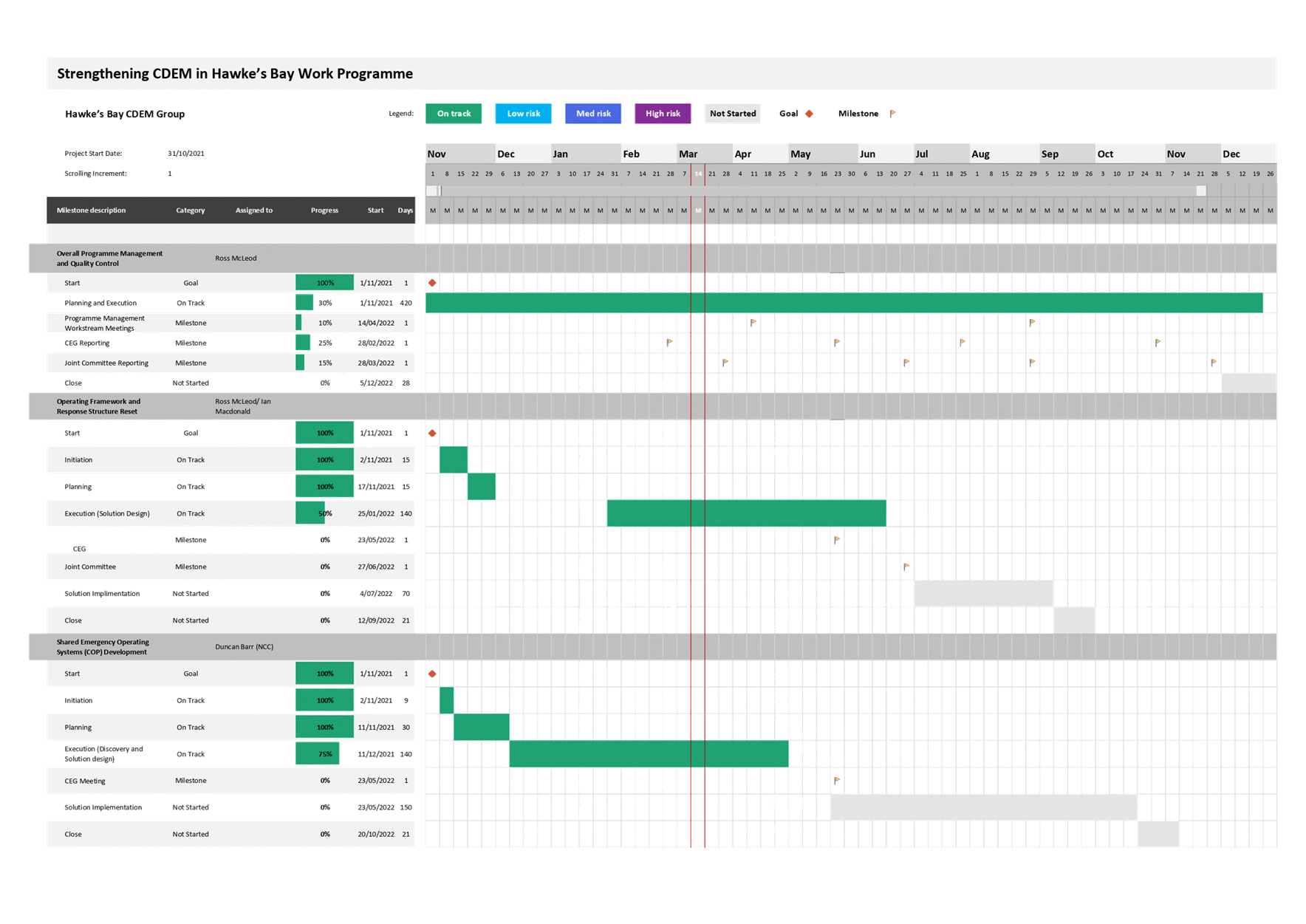
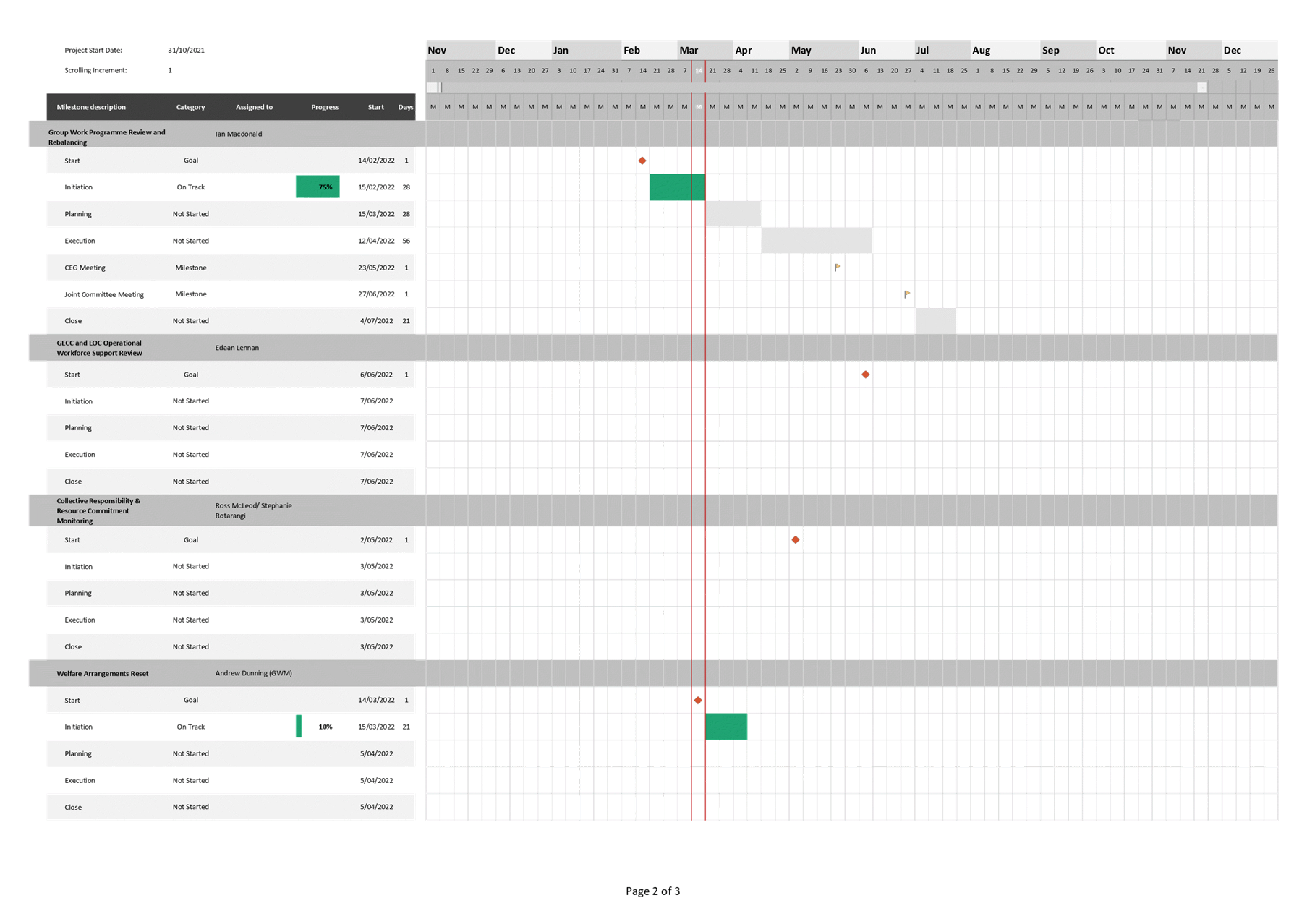
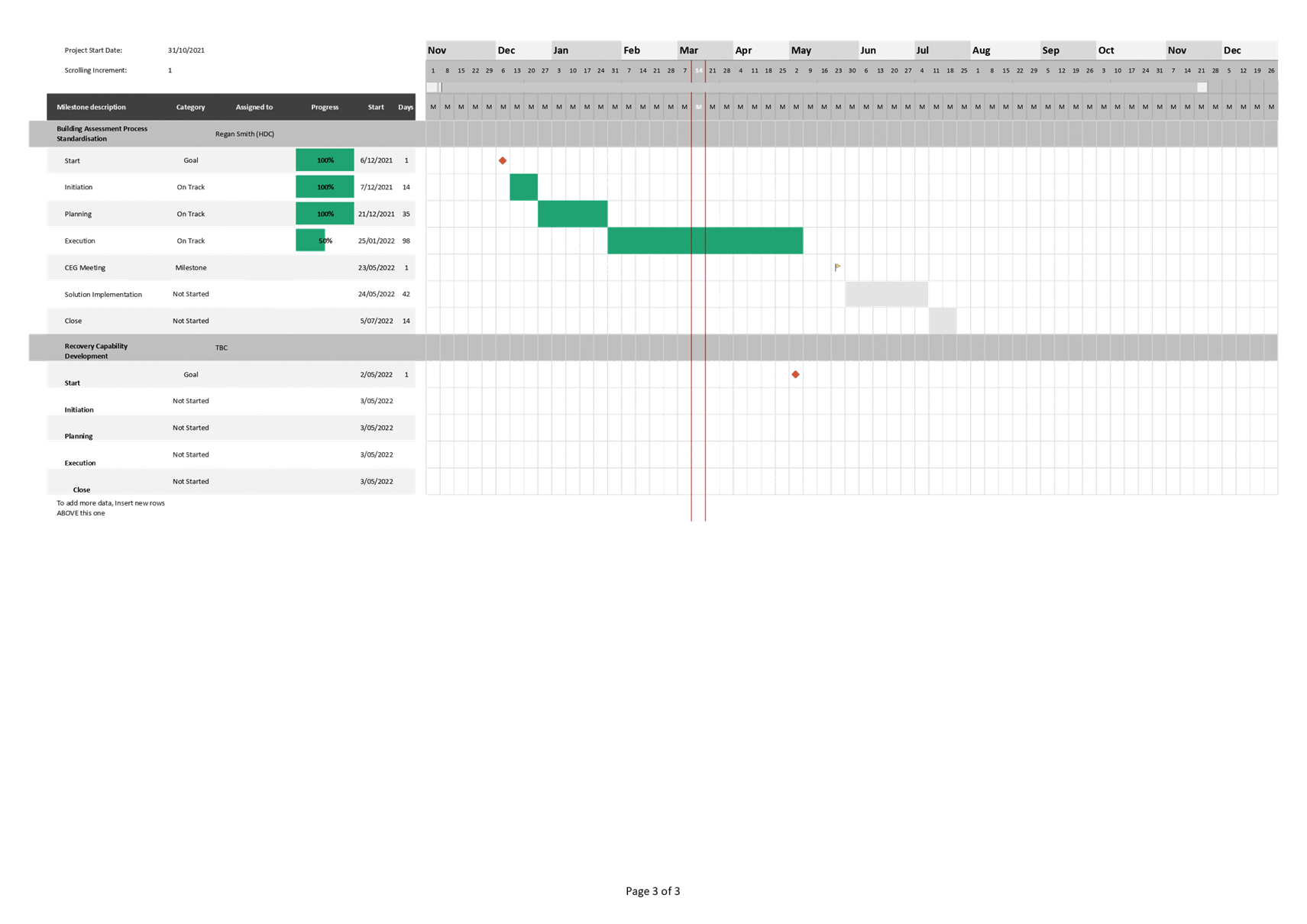
HB CDEM Group Joint Committee
JOINT
COMMITTEE
Monday 28 March
2022
SUBJECT:
Discussion of Minor Items not on the Agenda
Introduction
This document has been
prepared to assist the CDEM Group Joint Committee members to note any minor
items to be discussed, as determined earlier in the agenda.
|
Item
|
Topic
|
Member/Staff
|
|
1.
|
|
|
|
2.
|
|
|
|
3.
|
|
|






































